Rustic Rye Sourdough Bread Recipe
This post may contain affiliate links. Please read my disclosure policy.
Homemade rye sourdough bread is a glorious choice for sandwiches, or eating on its own. Made with a blend of whole wheat, bread flour, and rye flour, this naturally fermented loaf holds its shape and has a moist, chewy crumb. The rustic crust is deeply colored and boasts beautiful blisters!
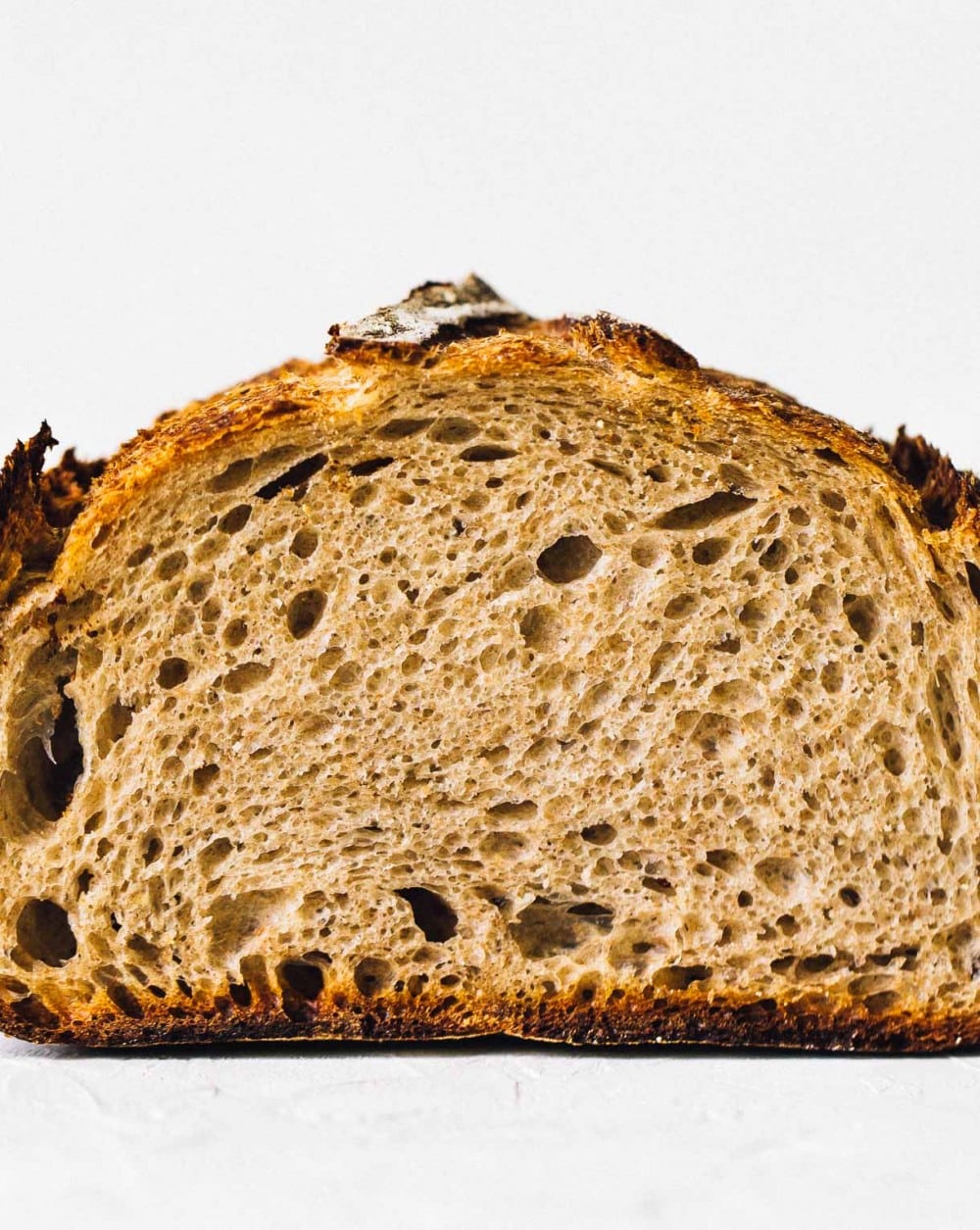
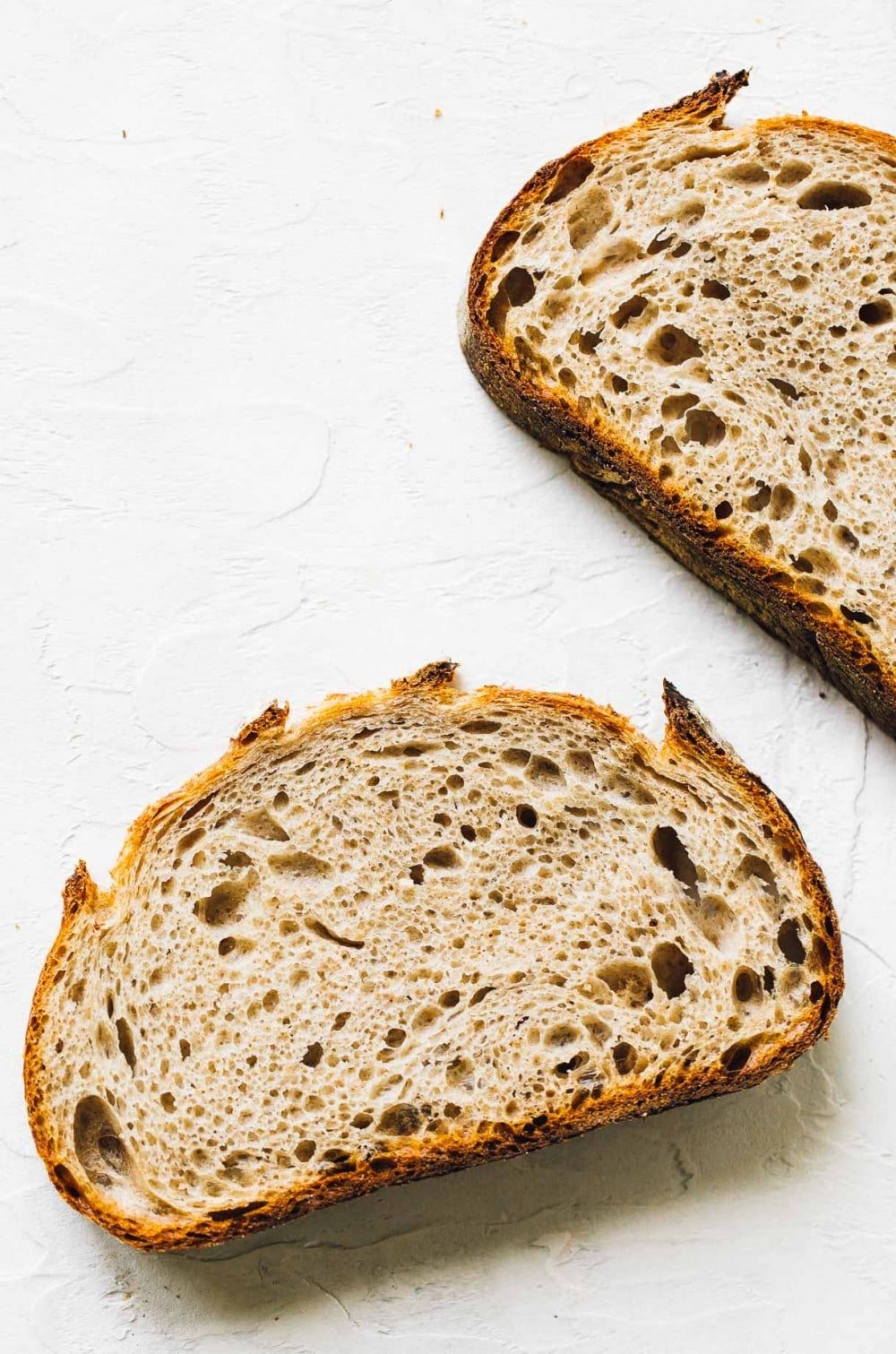
New to sourdough baking? You’ll need an active sourdough starter! I ship my well-maintened 13+ year old starter to anyone in the U.S! You can ORDER it here.
A great deli has a great rye bread for sandwiches, am I right?
I certainly love my Everyday Sourdough recipe for toast and my sourdough english muffins for epic breakfast sandwiches, but I had my heart set on creating a loaf that was the perfect vehicle for my recent craving of EGG SALAD. I’m fully aware how strange this craving is, but let me tell you, when I piled it on this rye sourdough with crisp lettuce and pickled red onions – it was a joyful moment.
This rustic rye sourdough is called such because of its crisp, deeply browned crust and artisan sourdough shape, rather than baking it in a pullman loaf pan to get perfectly square slices for sandwiches. I might invest in one of those in the future, but for now, I wanted to share a sandwich bread recipe that you could make with your regular sourdough baking tools.
It’s hearty. Has substance. A pleasant tang. And a shatteringly crisp crust.
What is rye?
Rye is a type of grain, different than wheat, that contains a low amount of gluten. This means it will not create the same gas trapping air pockets that a bread made entirely of bread flour does.
The dough will also feel wetter and stickier compared to working with all purpose and bread flours, known as high gluten flours. Don’t be alarmed – the dough will become less sticky by the end of your stretch and folds. Knowing this before making this recipe is important.
For these reasons, I like to use rye in combination with bread flour, for a balance of high/low gluten percentages. This allows for excellent structure in the loaf, while the rye contributes a complex flavor and wonderful softness.
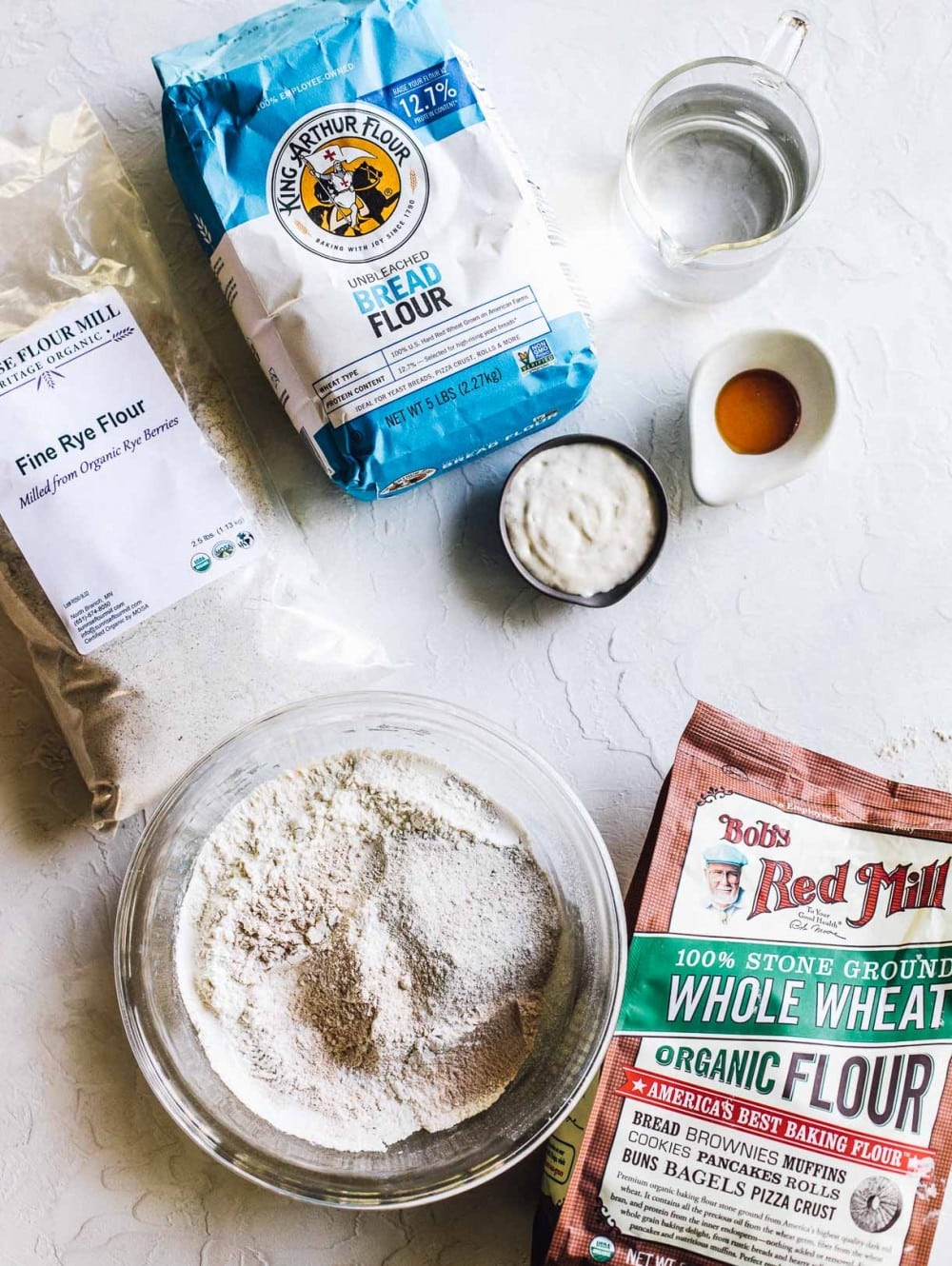
Why I love using rye flour in sourdough bread
- Complex flavor!
- Rye flour bodes particularly well to sourdough as it’s unique fruity, subtle sourness compliments the traditional notes of fermented bread.
- Less dense than traditional rye bread.
- Because of the chemical reaction that takes places in rye flour during fermentation, your loaf will be airier and fluffier than if you were to use rye flour in a bread made with commercial yeast.
- Bread has a moist, chewy texture that you can’t achieve with whole wheat.
- Because of rye’s ability to absorb and keep much of it’s moisture, the inside of a sourdough loaf made with rye flour will have a more moist texture.
- Your loaf will stay soft for several days after baking!
- Higher nutritional profile that whole wheat.
- Rye contains more nutrition than wheat flour does, and this is especially true when rye flour is added to sourdough bread. The slow fermentation increases the nutrient availability of the flour.

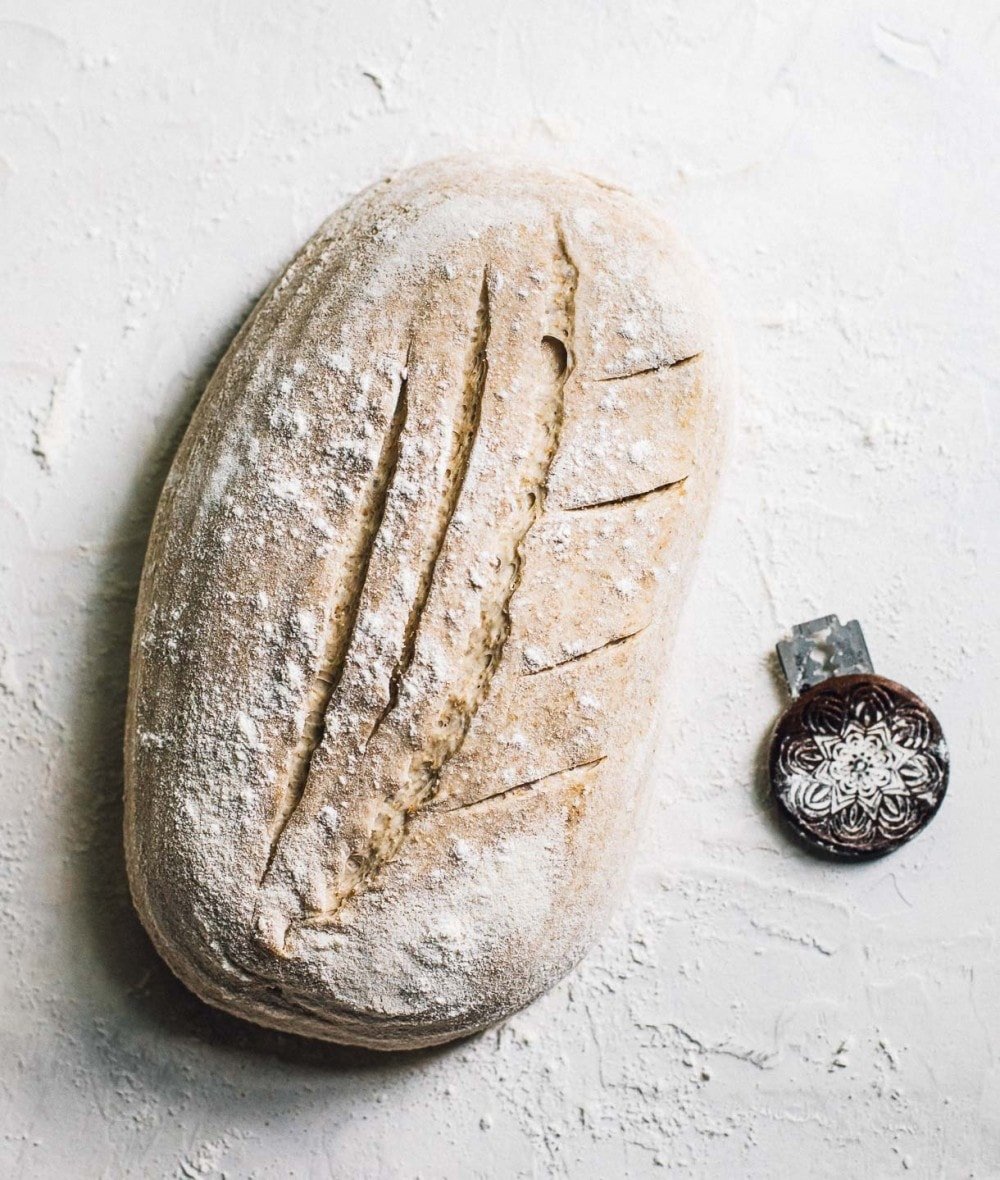
How to make rye sourdough bread that holds its shape
Because rye flour has little to no gluten content, it’s difficult to make a loaf of 100% rye bread. It can be done, but I wanted this to be a hybrid loaf, that would hold it’s shape for you, and still achieve a nice rise.
That’s why I used bread flour in combination with the rye and whole wheat, because it’s higher protein percentage is the key to the loaf holding its shape.
You’ll also notice this is a slightly smaller loaf, which makes the slightly wetter dough more manageable. Yes, you’ll notice the dough is slightly wetter than other sourdough bread you’ve made, and that’s okay! Just keep going with it. It will bake up with great structure if properly fermented.
WATCH this short video to see all the steps of making rye sourdough, so you know what to expect from your dough.
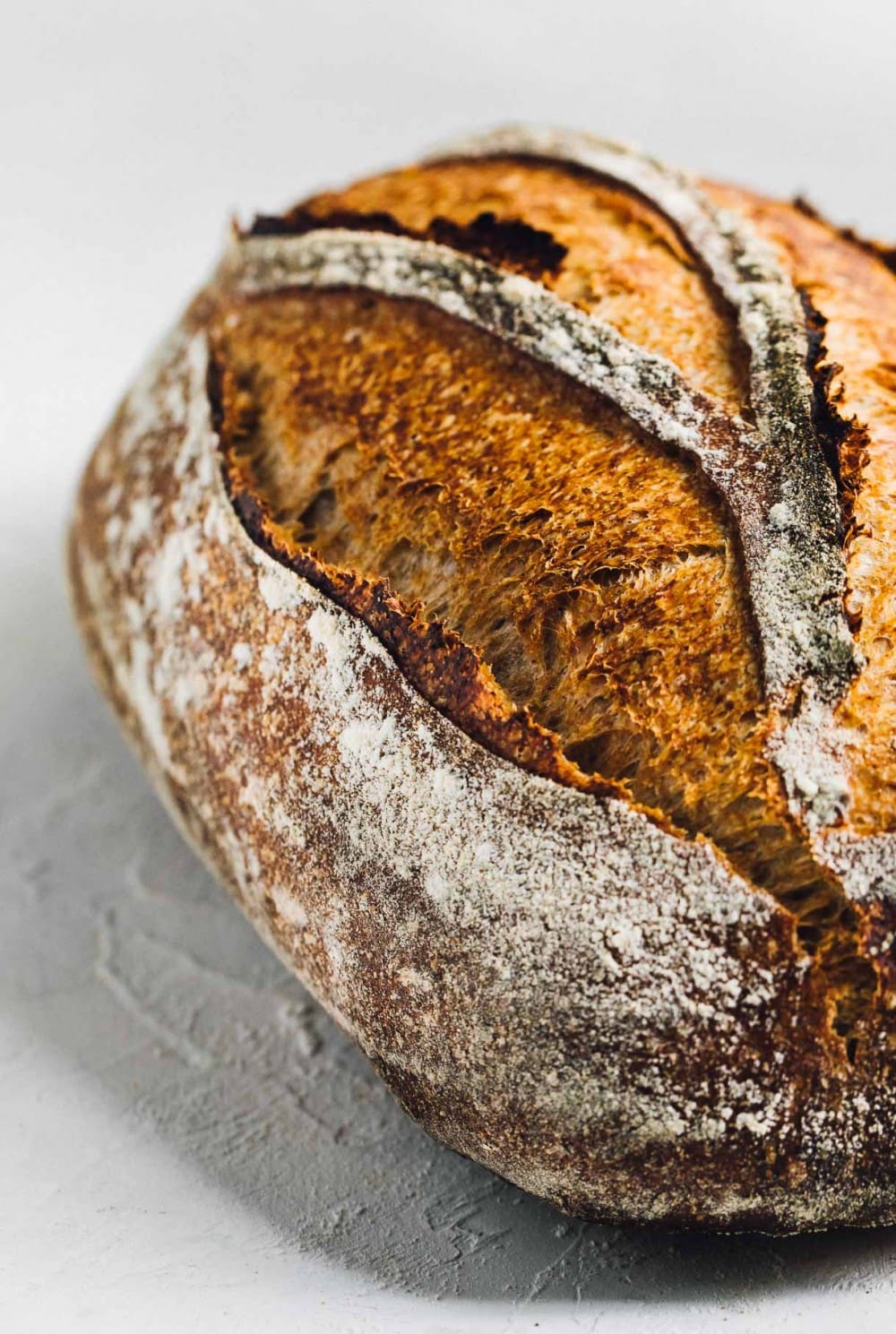
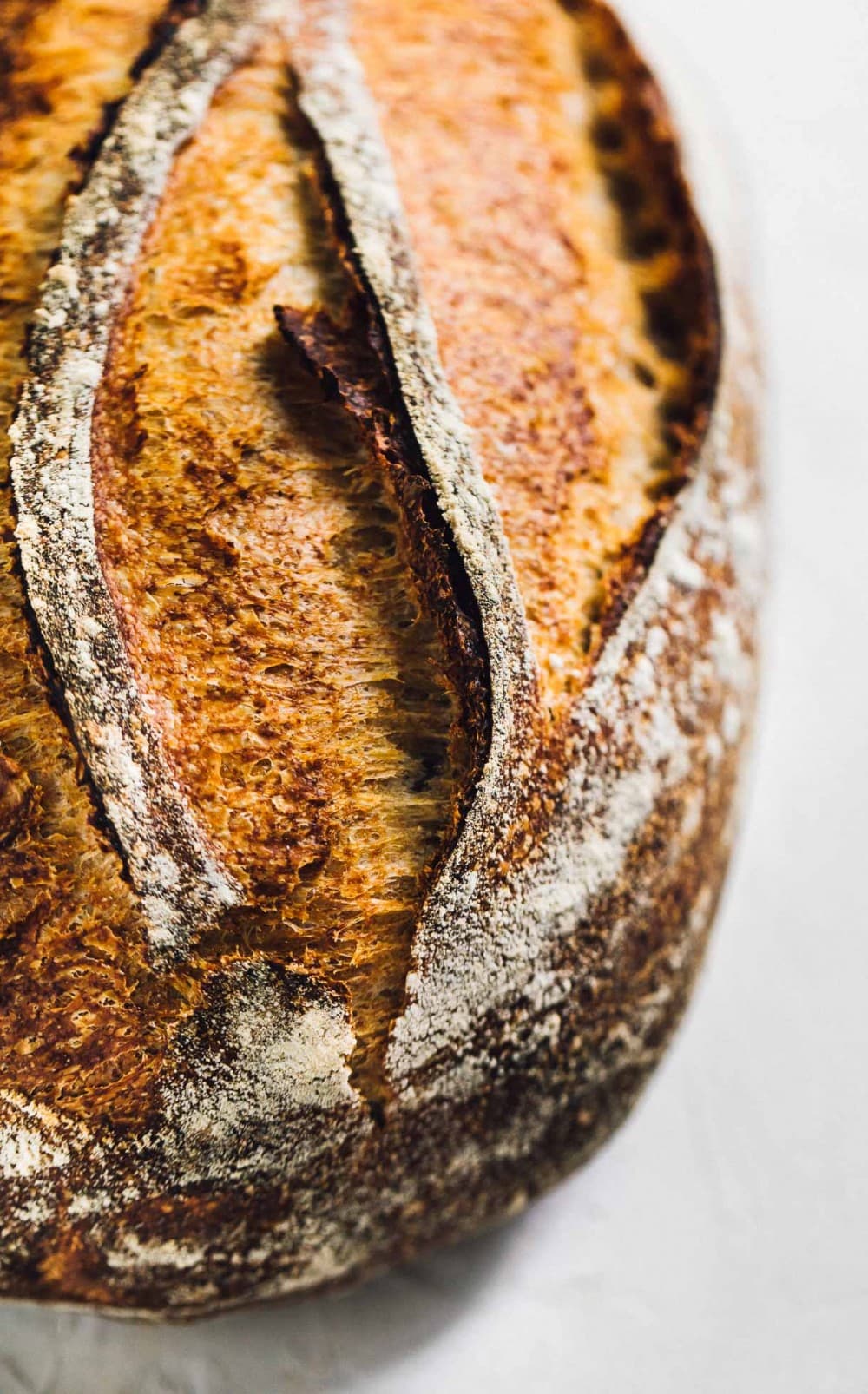
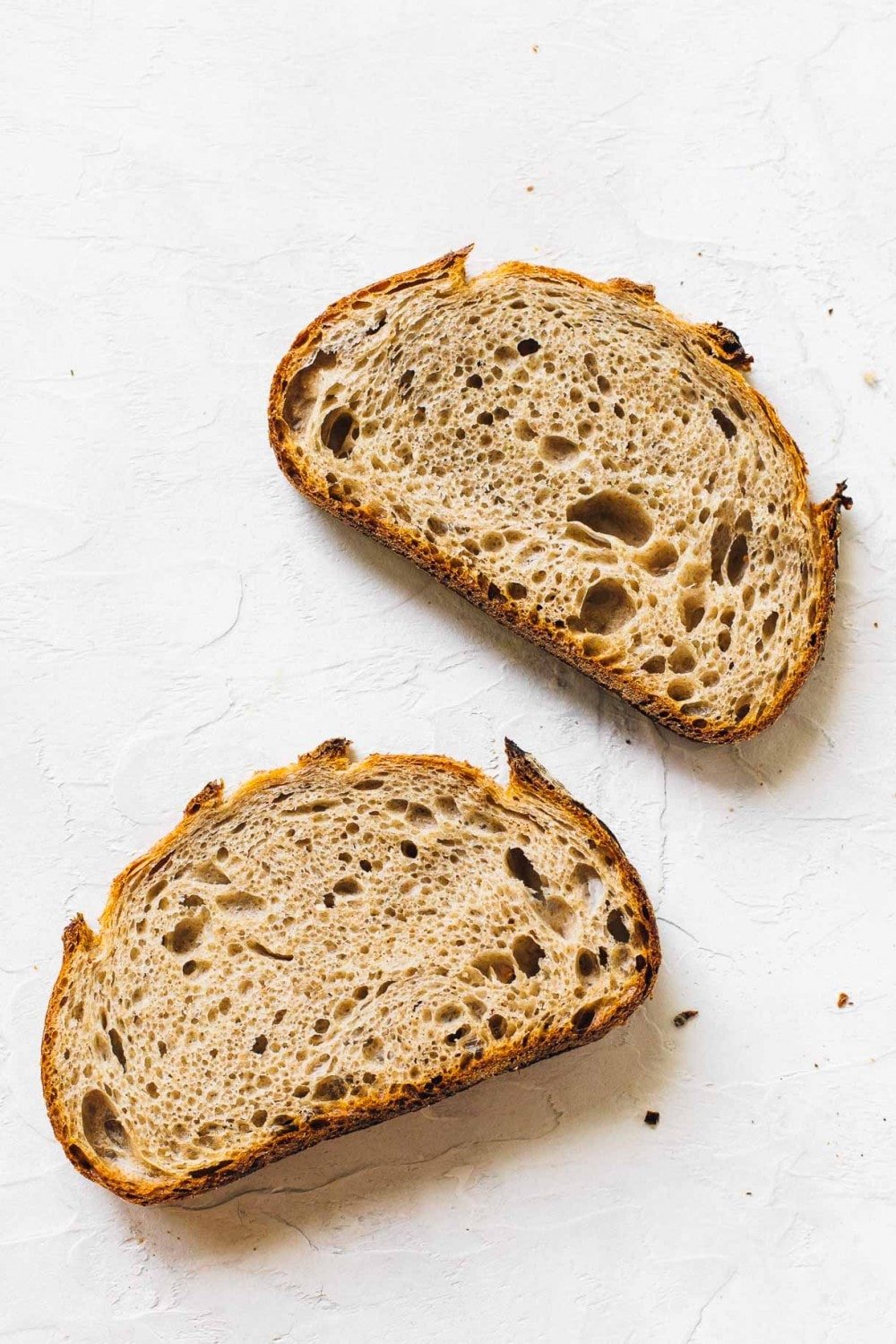
What should I bake an oval loaf in?
I tried using my round dutch oven for baking oval loaves in the past, but without fail the edges of the dough with hit the side of the pot, creating wonky, bulged shapes. I’m newly in love with the Challenger Bread Pan, which has a unique shape that allows you to bake any shape of bread in it! Bâtards, boules, demi-baguettes, and other loaves of almost any size.
Because of how it’s made, the perfect amount of steam is created inside the pan. I’ve never had better oven spring or thinner crusts.
This pan is magical. If you love baking sourdough, it is 100% worth having in your kitchen. You can learn more and purchase here.
My favorite things to eat on rye bread:
- egg salad
- whipped feta and tomato jam
- smashed avocado + lemon + smoked paprika
- ricotta + strawberry rhubarb jam
- salted butter
More sourdough recipes:
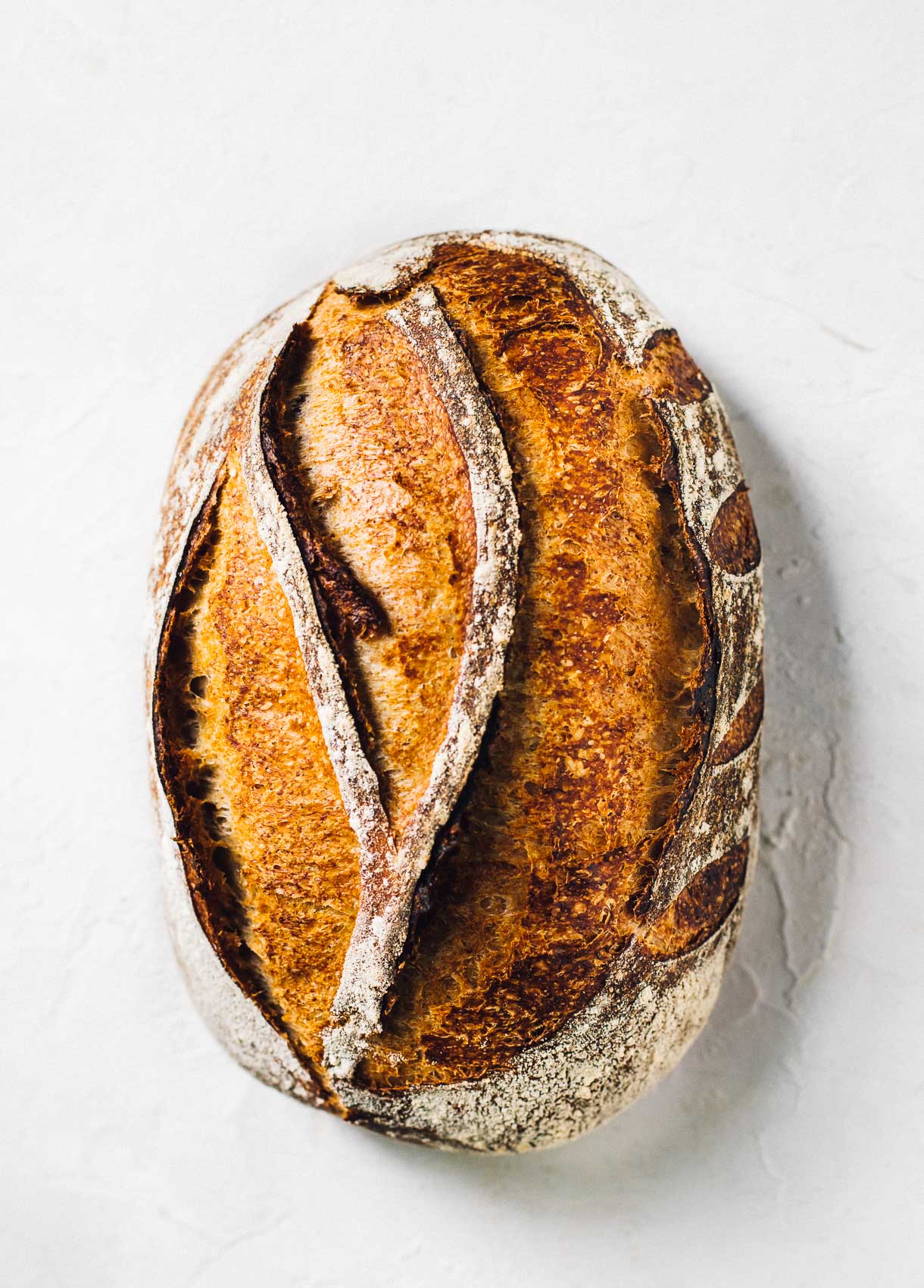
SCALE:
Ingredients
- 55 grams active sourdough starter
- 280 grams slightly warmer than room temperature water (about 80-85 degrees F)
- 15 grams honey
- 100 grams fine rye flour (also known as light rye)
- 260 grams bread flour
- 40 grams whole wheat flour
- 7 grams fine sea salt
Equipment
- oval banneton (can also use round)
Instructions
- Before beginning, it will be helpful to watch this SHORT VIDEO to see me make this bread, noticing that the dough will be stickier than normal because of the rye flour, but it will come together – you just have to trust!
- Add starter, water, and honey to a bowl. Whisk thoroughly until combined, with a fork. Add flours, and mix together first with the fork to start to incorporate, then with your hands until a shaggy dough is formed, and the bits of flour left just disappear. Sprinkle the salt on top and do not mix in, just leave it on top. Cover with a damp cloth.
- Autolyse: let dough sit for one hour, covered and undisturbed.
- Bulk ferment: Now you will knead the salt that is sitting on top, into the dough for about 2 1/2 minutes. There is no precise way to do this, just think of working the dough through your hands and up against the bowl, push and pull. You will start to feel the dough relax a bit around 1 minute. Then leave the dough alone, covered, for 30 minutes. This counts as your first set of stretch and folds.
- After those 30 minutes pass, perform a set of stretch and folds. Repeat 2 more times.
- Now you will let sit, undisturbed and covered with a damp cloth, for the remainder of its bulk fermentation. You will know it is finished with its bulk ferment when the dough has risen about 75% (just short of doubling) in size, is smooth and puffy on top, with a few bubbles around the edges. It will not be as jiggly as some sourdough you've made before. I find this takes between 5-7 hours, depending on the temperature of your home. If the temperature in your home is above 72 degrees, this will be on the lower end; if it is cooler it will take on the longer end. Always go by the look and feel of your dough to know when it is finished proofing rather than time.
- When finished with bulk fermentation, lightly dust your work surface with flour. Put dough onto the work surface, and pre-shape. Then let sit for 15 minutes on your work surface.
- Then shape your dough using the video attached here as a guide.
- Place dough into your flour dusted banneton, (or flour dusted linen lined banneton) seam side up. (Optional, you can wait 15 minutes after placing it in banneton, and pinch the perimeters of the dough into the center to hold the shape even more, called stitching.) The dough will now go through its final rise. You can do this on the counter, which will take about 1 1/2 to 2 hours at 70 degrees F for the dough to puff up and be jiggly. It will not double. OR you can do the final rise overnight in the refrigerator, with the banneton covered in a plastic bag or with a very damp cloth. You need this for holding moisture in.
- Time to bake. Preheat your oven to 475 degrees F, with your dutch oven preheating inside the oven. When the oven is preheated, flip your dough out gently onto parchment paper and score your dough. If you did the final rise in the refrigerator, take it straight from fridge to scoring. You should score it cold, and DO NOT need to let it come to room temp.
- Then put scored dough into the dutch oven on the parchment, and put cover on. Turn oven down to 450 degrees F and slide dutch oven in. Bake for 20 minutes, then remove cover.
- Turn heat down to 430 degrees F, and bake for 25 more minutes, until crust is golden brown and crackly. Remove from oven, and remove bread from dutch oven and place onto a cooling rack.
- Wait AT LEAST one hour to cool otherwise, the interior will be gummy.
Did you make this?
tag @heartbeetkitchen on instagram and hashtag it #heartbeetkitchen

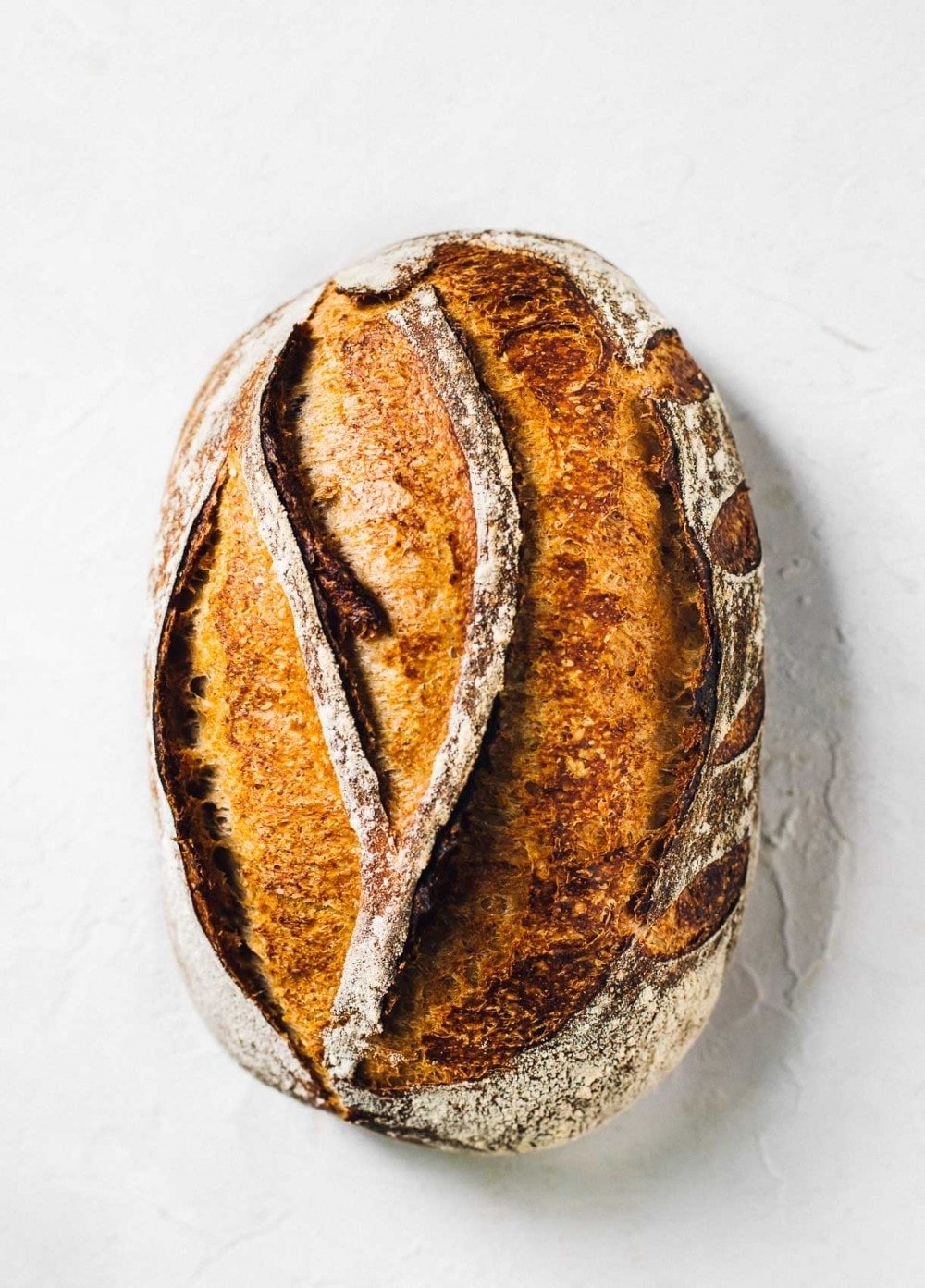

Corinne
April 25, 2024
Patterns are easy to understand
Becky A
April 21, 2024
I do not have a banneton, is that necessary? Other bulk ferments I have done in a straight sided glass bowl. Thoughts?
Kathy Lorenz
April 20, 2024
I just made this. I’ve been practicing and I felt ready. Omgoodness!! It was easier than I thought because of the excellent instructions, tips and video. I couldn’t wait, so I cut into it and my family devoured the first loaf. So, so delicious!! I think this is my absolutely favorite recipe. Thank you so much!!
Amanda Paa
April 20, 2024
Yay, love hearing your success and joy! Thanks for making the recipe.
Deb P
April 19, 2024
This bread is awesome!! I use molasses instead of honey and add caraway seeds.
Eliz
April 18, 2024
Can I bake this in a loaf pan? Or should I find a different recipe for that.
Thanks, looks like a great recipe.
Amanda Paa
April 18, 2024
I think this would be too much dough for a loaf pan!
Janny
April 11, 2024
HI,
I am new to sourdough bread making and am having success with plain bread flour with 100 gram starter dough. I am going to try this recipe but am wondering why there is only 50 grams of starter being used with that amount of flour? Thank you.
Tim
April 12, 2024
The less starter you use, the longer the bread will take to ferment. The added advantage here is that it develops a lot more flavour as a result. I have modified this recipe a bit but I use 70g starter in my loaf. That’s also because it’s getting a bit colder in my kitchen and I want the ferment to go a little quicker. It’s so fun, good luck
Tim
April 3, 2024
Thank you so much for this recipe, I have made it probably a dozen times. This week, I made the dough 20% bigger than the recipe indicates. making a slightly less than 1kg loaf. I also never add the honey but often substitute sultanas to make it a fruit rye. This week I also used a strong (12.7%) wholemeal bread flour as the main flour, using white as a smaller percentage. Despite all of my experiments with this recipe, I seem to always come out great! Your pizza dough recipe is also the best one I have ever used. Thank you!
Robert disalvo
April 2, 2024
Hello and again you dazzle in this perfect recipe! Thank you so much. I was wondering if you tried turning this into a more pumpernickel style? Thanks again for all your perfect recipes!
Tracy Wilkinson
March 28, 2024
The nicest, tastiest and most delicious recipe to date! I think adding a touch of honey and rye flour is genius and 4 loaves have all be beautiful. Very happy with clear and concise instructions. Don’t delay, do it ❤️❤️
Amanda Paa
March 29, 2024
Makes me so happy to hear that, Tracy! Thanks for making the recipe.
Lori L Stevens
March 25, 2024
I don’t have a scale. Would you convert the weight measures to cups, Tablespoons, etc?
Caroline
March 25, 2024
Is the honey for taste or for structure? Have you tried subbing molasses in for honey?
Amanda Paa
March 25, 2024
Molasses works great, too!
Maggie
March 21, 2024
I would like to try this recipe but only have dark rye. Should I not use it?
Amanda
March 28, 2024
I prefer using the dark rye! I just add a little extra water and caraway seeds for taste .. plus I heard it helps make the starter a bit more active as a bonus !
Lisa
March 30, 2024
How much extra water do you use for dark rye? That’s all I have and would love to try :)
Sandra Zarou
March 19, 2024
I’m getting ready to try this rye bread recipe. Can’t wait! What is the longest you would leave the dough in the refrigerator? have you ever left it as long as 24-36 hours?
Amanda Paa
March 19, 2024
Can definitely go 24 hours!
LuAnn
March 16, 2024
can you use dark rye flour, instead of light rye, flour?
Amanda Paa
March 16, 2024
Hi! Medium rye or light rye are what this recipe was developed for.
Maria Waters
March 16, 2024
I made this bread today. It is definitely a winner. Lovely favours! I had to hold hubby back from cutting it too early!! Thank you :)
Amanda Paa
March 16, 2024
So glad to hear that, Maria!
Julia
March 11, 2024
I’ve made this recipe four or five times in the last two months. It’s so delicious and my husband’s favorite bread I make! I’ve played around with it and I like to multiply the recipe by 1.5 for a bigger loaf, add caraway seeds, and then bake it in a loaf pan. Delicious for sandwich bread. I’ve made it exactly following the recipe too and you really can’t go wrong.
susan handloff
March 9, 2024
OMG!!! Moist, flavorful,bubbly, crusty…My favorite sourdough recipe yet! I have been baking in a dutch oven in my air fryer, since my oven is on the blink. My air fryer only heats to 400 degrees, so I left the bread in the dutch oven with the cover on for 1 hour and it turned out PERFECTLY. I’m staying home from the party of the year, eating bread in bed. Heaven.
Amanda Paa
March 10, 2024
wow, you made sourdough in air fryer – amazing! had no idea that could work.
Norali
March 7, 2024
Hi! How long can I leave it in the fridge for the 2nd rise? Got my timing wrong and hoping I can just leave it in the fridge closer to 16hrs…
Amanda Paa
March 7, 2024
Not too worry, that will be just fine!
Megan Meridew
March 5, 2024
I’ve made three loaves with different brands of rye flour. The first and second times it was wet as the recipe said. The second time it was much drier. Every loaf was fabulous tasting. Definitely a keeper.
Amanda Paa
March 6, 2024
So great to hear, Megan! Love that you are baking so much. Yes, each brand of rye flour will differ in their absorption rate. And actually, each time you buy a new bag, even of the same brand, it can change a bit because of the weather during the growing season of that harvest.
Kim
March 5, 2024
Turned out great! Crust was thick and crusty and inside soft and tasty! I hollowed one loaf out for a homemade dill dip appetizer and served with a second cut up for dipping- complete hit! Will make right away again for Reuben sandwiches. Thank you!
Judy
March 5, 2024
ItI’m making for first time.not sure how to tell if my starter is active (it’s in fridge now. I’ve read to many recipes so Im confused. Some said take out of fridge, get to room temp, feed 111 ratio till active then weigh.
Dawn
February 29, 2024
Best ever!! Thanks Amanda
Amanda Paa
February 29, 2024
Yay, so glad you enjoyed the recipe!
Rony
February 28, 2024
He estado viendo tu receta y me gustaría me ayudarás con una receta para panes o solo tendría que multiplicar las cantidades muchas gracias de antemano
Sarah
February 25, 2024
I want to make this but my baby isn’t old enough to have honey yet. But she LOVES chewing on the sourdough crust. What is a good substitute? Sugar??
Amanda Paa
February 25, 2024
Hi! You could substitute maple syrup! Or sugar would also work.
Shannon Stovsky
March 2, 2024
the honey is cooked…..
Kathleen
March 6, 2024
Babies should not be given baked goods with honey. The temperature and pressure needed to kill botulism spores will not be reached.
Bobbie
February 24, 2024
Hi, I just did the salt stretch and fold. Am I doing 2 more S & F or 3 more? Step 5 was not 100% clear to me. Thanks!
Amanda Paa
February 24, 2024
Hello! You do 4 total sets of stretch and folds. Salt + stretch and fold is #1, then 3 more times, 30 minutes apart.
Tracy
February 24, 2024
Hi Amanda! I am so excited to try this recipe with fresh milled flours. Are there any mods that I need to make? Also, are the temperatures written using the Challenger bread pan? I am a new user and have not quite gotten the temp right. Do you use ice ? Thank you!!
Amanda Paa
February 24, 2024
Hi Tracy! I would try making it as is the first time; if anything the dough might soak up a bit more water because of the fresh milled grains, but this is a stickier dough anyways so that might not be a bad thing. I would adjust as needed on the 2nd bake, according to how the first went. Yes, this recipe is temperature I use for Challenger Bread Pan; I usually don’t add ice, but you can add a cube if you’d like.
Tracy
February 24, 2024
Thank you! I may be trying the recipe with fresh milled on 1st bake – I don’t have the other commercial flours sooo…I’ll let you know how it goes!
Mom24
February 21, 2024
So freaking good. Wow! Thank you.
Amanda Paa
February 21, 2024
Yay, so glad you enjoyed the recipe!
Jennifer Gershon
February 20, 2024
So happy to have found this page. Just started baking 2 weeks ago and the rustic rye has been the best recipe out of the 8 loaves I’ve baked.
I like how forgiving the recipe has been too. I had a scale mishap and had to guesstimate the flour amount on one loaf🤣
Amanda Paa
February 20, 2024
So glad to hear that! And nice work on the guesstimating!
Jenn Gershon
February 20, 2024
Seriously. So happy to have founds this. Did two this morning with dried fruit and pecans. Perfect! Just subscribed. Thank you !
Amanda Paa
February 20, 2024
oh, that sounds amazing with the dried fruit and pecans.
Alison Hainley
February 15, 2024
Can you use a medium rye in this recipe? That’s all I can find in my area
Amanda Paa
February 15, 2024
Yes, that will work!
Danielle
March 3, 2024
I was going to ask if a dark rye would still be good? That’s all I have on hand I think…
Casey Riitano
February 13, 2024
I finally succeeded in creating a rye starter and used it for this recipe and this is the first time I’ve truly had success with any rye bread. I missed the second shaping before fridge ferment but hopefully it doesn’t effect final product.
Amanda Paa
February 13, 2024
Yay, so glad to hear that!
Kat
February 13, 2024
I am new to baking bread and making this loaf has given me confidence. I have a loaf bulk rising and will add sunflower seeds at last fold. Thank you for this recipe.
Amanda Paa
February 13, 2024
Terrific! And I bet that will be delicious with the sunflower seeds.
Kay Sea
February 16, 2024
This is my go-to rye bread. I make about 2-3 loaves a week. I love gifting it out, everyone raves about it. I can’t tell you how many times I’ve shared this recipe!
Amanda Paa
February 17, 2024
That’s so wonderful to hear, happy baking!
Stephanie
February 12, 2024
Thank you for sharing your recipes and all the tips Amanda! My loaves have never been better. I started baking sourdough 6 months ago but since finding you, my bread is so much better. This Rye loaf is superb! Greetings from the UK!
Amanda Paa
February 12, 2024
Hi Stephanie! What a lovely note. So glad to hear you are finding success!
Alice Martin
February 15, 2024
Is it possible to make this without the honey?
Ellie
March 5, 2024
I tried it and it works just fine without the honey. No adjustments were needed, I just didn’t add the honey.
Stefanie
February 9, 2024
Hey, I would love to use this recipe and make a marbled boule out of it. When adding cacao powder, do I need to increase the water in it?
Amanda Paa
February 9, 2024
Hello! I haven’t ever tested added cacao to this recipe, so I’m not able to guide you. Sorry!
David Kouri
February 8, 2024
Just made this recipe for the 3rd time and it turned out deliciously fantastic!!! It will pair well with the borscht my wife just made. Yum!! Thank you for sharing your passion and recipes.
Amanda Paa
February 8, 2024
Great to hear, David! And what a fabulous meal; borscht + rye bread!
Toni
February 6, 2024
Thank you for the recipe! Planning to try it without the honey as we have a prediabetic in the family (so trying to reduce the carbs). Any adjustments that may be needed or is the honey in the recipe needed primarily for flavor? Thank you!
Amanda Paa
February 6, 2024
Hi Toni! The honey is used to balance the flavor. It will be okay without it, but if you can keep it in (the amount is spread out throughout the whole loaf), that would be ideal with how the recipe was developed.
B
February 5, 2024
Amanda, thank you so much for this recipe! I’ve never baked any kind of bread before so I’m a very beginner. I’ve made 5 of these loaves over the past two weeks because they are so delicious and we can’t stop eating them! I’m still working on succeeding with the shaping part but when the loaves taste this good, who cares if I can’t make them pretty yet! Delicious earthy flavor and easy to follow recipe!
Amanda Paa
February 5, 2024
That’s so great! And the more practice you do, the prettier the loaves will get! Thanks for making the recipe.
Heidi
February 3, 2024
Can I use white flour starter? Or do I need a rye flour starter?
Amanda Paa
February 4, 2024
Hi! Rye starter not required, I use a 100% all purpose flour starter for this recipe.
Elaine
February 2, 2024
5 stars from me too. It always works even when not too precise in measuring.
Amy H
February 1, 2024
This is by far the best bread of any kind that I have ever made. My husband says it is gold medal worthy, and rye bread s his favorite. I made it a few days ago and two more loaves are proofing. Two more tomorrow. I am keeping some and gifting some.
Amanda Paa
February 2, 2024
Oh wow, love to hear that Amy! Thanks so much for making the recipe.
Kat
January 31, 2024
I’ve made this loaf 3 times now and the last loaf was amazing. I cold fermented in fridge overnight and that really helped it rise. I’m wondering if anyone has tried adding seeds or cracked rye berries to this recipe and if so, how did it turn out?
David I Bigio
January 31, 2024
I am a new bread maker. This recipe and instructions were educational and easy to follow. I have never failed making the bread. My family and their kids love it and keep asking me to make it!!!
Amanda Paa
January 31, 2024
That makes me so happy to hear! Thanks for the note!
Skirkly
January 28, 2024
Loved this. Tastes so delicious. It rose perfectly and got an ear and looks fabulous. I didn’t find it sticky, but I am used to some higher hydration doughs. I will be making this again and again. Husband loved it too.
Amanda Paa
January 28, 2024
So great to hear! Thank you for making the recipe.
Diana
January 27, 2024
Great recipe! However, like all of the sourdough breads I make, I added the salt to the autolyse part. I did not fold it in as stated. No need!! It turned out perfectly! I’m enjoying it now as a club sandwich!
Amanda Paa
January 28, 2024
So glad you enjoyed the bread, Diana!
Doreen Dawe
January 23, 2024
The best recipe ever
Toral
January 15, 2024
I just made this bread and it came out so perfect. In the past, I’ve struggled with getting a rise from whole wheat and rye sourdough loaves, but this rose beautifully. Can’t wait to try more recipes.
Amanda Paa
January 15, 2024
So great to hear of your baking success!
Deffia Schoos
January 14, 2024
Just baked this today I did the cold ferment in the fridge! My new favorite bread!
Amanda Paa
January 15, 2024
Yay, love hearing that!
Carolyn
December 30, 2023
Hi Amanda,
I’m looking forward to trying this recipe. If I want to incorporate caraway seeds, at what point would I add them?
Thanks!
Amanda Paa
December 30, 2023
Hi Carolyn! I like to add in the 2nd set of stretch of folds.
Carolyn
December 30, 2023
Thank you!
Summer Whelchel
December 26, 2023
I was looking for a rye sourdough recipe and Amanda makes this one so easy with her instructions and help videos! I also love having an artisan loaf I can bake in one day if I have the whole day at home! Gifting two of these for Christmas presents today!
Amanda Paa
December 26, 2023
Your photo of your bake on Instagram was beautiful! Thank you for making the recipe, so glad you enjoyed it!
Geli
December 19, 2023
Love this sourdough recipe. I used dark rye flour instead of the light one and turned out perfectly too, as do all of Amanda‘s recipes I tried out so far.
Following the instructions on the videos really made my sourdough bread turn out better than ever.
Thank you!
Amanda Paa
December 19, 2023
Oh, so glad to know the dark rye worked okay!
Isabel Cooper
December 18, 2023
Hi Amanda. I’ve been baking sourdough since Covid. I’ve made many loaves and thought there was no room for improvement. Then I ran across your simple sourdough recipe. I love your instructions, tips and recipes. So… I ventured out of my box. I made this rye sourdough
Yesterday and I’m waiting for my oven to reach 475°. I’ll keep you posted!!
Amanda Paa
December 18, 2023
Great, let me know how it goes!
Isabel Cooper
December 18, 2023
Delish! Love the rye. A nice subtle taste and I get it mostly in the crust. Can’t wait to see other recipe to use with my stsrter.
Amanda Paa
December 18, 2023
Yay, glad you enjoyed it!
Mohsen
December 12, 2023
I’m so looking forward in baking this bread! Curious, do I need to multiply the ingredients by 2 if I wanted to bake 2 loaves?
Amanda Paa
December 12, 2023
Hi! Yes, you will need to multiply all ingredients by 2 for a double batch.
Madelaine
December 12, 2023
Another weekend, another one of your sourdough recipes. I had some leftover rye flour from making my starter in early 2023 that I wanted to use up. Compared to a seeded loaf or a loaf with lots of inclusions, I didn’t think this recipe was going to wow me as much as it did. I love the texture and crumb (perfect for sandwiches) and the flavour is so hearty and rich. I got an amazing dark crust as well!!
Looks like I’ll be buying more rye flour. :)
Amanda Paa
December 12, 2023
Yay, so glad to hear that! I love this loaf for sandwiches, too!
Naama
December 3, 2023
What size round banneton do you suggest using? Is 8.5 too big? I’m worried it’ll spread too much. Thanks!
Amanda Paa
December 3, 2023
8.5 inch round is what I use (or 10 inch oval); it will not be too big!
Charlie
November 30, 2023
Ugh, I made the beautiful dough but I don’t have a Dutch oven. How do I bake it instead?
Amanda Paa
November 30, 2023
Hi Charlie! Here are ways to bake sourdough without a dutch oven.
Feeb
December 1, 2023
I don’t have a dutch oven either, I just use a casserole dish, works fine. :-)
Katie
November 29, 2023
Amanda, great recipe. I like things simple. To that effect you need to get a danish dough whisk. If you like baking bread as much as I do this inexpensive tool will make your life so much easier! I also feed my starter with part plain flour and part rye flour as this makes for a tangier starter and overall more flavorful bread!
Amanda Paa
November 29, 2023
Oh, a dough whisk is going on wish list, thank you for the tip!
Roberta
November 29, 2023
I am out of WW flour..can I just add bread flour in its place or is it integral to the recipe ?
Amanda Paa
November 29, 2023
Hi Roberta! I haven’t tested it with that substitution. Let me know if you do!
Shelbie
November 22, 2023
Making Sourdough bread doesn’t need to be fussy as many are. Amanda’s recipe was straightforward and forgiving with excellent results to boot!
Her recipe will be my “Go To” for Sourdough Rye!
Amanda Paa
November 22, 2023
So glad you enjoyed it, thanks for making the recipe!
Rany
November 18, 2023
I’ve made this bread for the 4-5th time and it’s been amazing every time! I would have made it with caraway seeds but I’m all out
I have a terrific rise every time!!
Amanda Paa
November 19, 2023
So glad you are enjoying it!
Lili
November 10, 2023
This was so fantastic, I live in Hawaii with super high humidity and a constant temp around 78-82 and your recipe loved this environment. I used dark rye and it worked just fine. This will be a shared recipe with all my bread geek friends, thank you so much!!
David Grinvalsky
November 8, 2023
I wish I could post a picture, the results speak for themselves in this case. I’ve been learning the art of making sourdough for a little over a month and have had mixed results. Follow this recipe step by step and you won’t be disappointed at all. Thank you, Amanda! What’s next?
Amanda Paa
November 8, 2023
Hi David! I’m so glad you enjoyed the recipe! And good thought, maybe I will see if I can get some tech work done that would allow readers to submit photos with their comments. Up next, have you made the soft sourdough english muffins yet? They’re so good!
David Grinvalsky
November 8, 2023
Wow! You read my mind, I just told my wife, the next thing I want to try is English muffins. Thanks Amanda, clicking the link now!
Howard Maki
November 2, 2023
In the directions for your rustic sour dough bread step #5 states to perform a set of stretch and folds and then repeat 2 more times. Doe that mean that you wait 30 more minutes between the 2 additional stretch and folds, or just perform them one after the other?
Amanda Paa
November 2, 2023
Yep, wait 30 minutes in between each additional set!
Mars
October 31, 2023
What size Dutch oven or 2 small Dutch ovens to use? Thanks
Amanda Paa
October 31, 2023
Hello! You can use a 5.5 quart dutch oven or larger.
Bambi
October 23, 2023
Sounds so good! Can I do the bulk ferment in the fridge overnight, then allow to come to room temperature and do final rise the following day? Rather than bull ferment on counter, and final in the fridge….
Amanda Paa
October 23, 2023
hello! you’ll need to do the bulk ferment on the counter, as this gives the yeast the happiest temperature for it to thrive in and give you the rise you’re hoping for. refrigeration nearly stops fermentation, so it just would never get the yeast activity needed.
Jonathan
October 23, 2023
Hi I want to try this receipe, I was just wondering can I use my stand mixer to mix the dough? Any special instructions?
Amanda Paa
October 23, 2023
Hi Jonathan! I haven’t tested this recipe using a stand mixer. I think you could do so for the first initial mix, but I would do the stretch and folds by hand to not break the gluten strands you’ve built.
Jonathan
October 23, 2023
Ok thanks I will give it a shot.
Cristina
October 20, 2023
Thank you for such an amazing recipe Amanda! I’m a super fan of rye bread!
I made it once and it turned out very nice although the humidity where I live it’s pretty high.
So I’m baking it again and following your recommendation of reducing the amount of water, let’s see how it goes…
I have a question, if I do the overnight step, it means that I jump from step number 5 to step number 9?
Amanda Paa
October 21, 2023
Hi Cristina! You will still do the bulk fermentation on the counter, so all steps of the recipe. In step 9, you will just put in the refrigerator rather than let it go through its final rise on counter. “You can do this on the counter, which will take about 1 1/2 to 2 hours at 70 degrees F for the dough to puff up slightly and be jiggly. OR you can do the final rise overnight in the refrigerator, with the banneton covered in a plastic bag. You need this for holding moisture in.”
Laura Pittelman
October 19, 2023
This is loaf has the best flavor of any I have ever made. I would like to make this, but larger, only I have no idea how to convert the numbers for quantities or temperatures and cooking time. Are you able to provide that ? Pretty please?
Amanda Paa
October 20, 2023
Hello Laura! You could increase all ingredients by 10 to 15% to make it larger (multiply each gram weight by .10), bake time would be the same. However, I do like prefer this size of loaf for handling abilities of the dough.
Naama
October 18, 2023
Hi Amanda! This recipe is absolutely fantastic thank you so much! I’ve made delicious loaves many times but I haven’t tried the overnight rise in the fridge yet – I’ve just made it all in one day. I want to try overnight in the fridge soon though. How long can it be in the fridge for? Could I make the dough Thursday and put it in the fridge until I want to bake Friday in the afternoon? Is there a max amount of time the sourdough should be in the fridge? 12 hours? Or is longer (like 15-18 hours) okay? Thank you!!!
Amanda Paa
October 18, 2023
Hi Naama! I’m so glad you like the recipe; thank you for making it! It will not be a problem to be in the fridge for 15 to 16 hours. Enjoy!
Nicole
October 4, 2023
I don’t have a dutch oven. Do you have suggestions for what to do in this case? Thank you!
Amanda Paa
October 4, 2023
Hello! Here are some suggestions on how to bake sourdough without a dutch oven.
Lisa
September 30, 2023
Delicious!! Anyway to make it a ‘seeded’ rye? Per hubby’s request. Thx
Amanda Paa
September 30, 2023
So glad you liked it! I haven’t tested the recipe with seeds in the dough, but you can add them to the crust. Once you have shaped your dough, brush it with water, then roll the dough in raw seeds of choice. Put dough into banneton and proceed as usual.
Rany
November 4, 2023
I made this rye bread once without the seeds and another time with seeds (anise, fennel and caraway seeds). I added them along with flour, starter etc. both came out wonderful.
Amanda Paa
November 4, 2023
Oh, that sounds wonderful with the seeds!
KKP
September 28, 2023
How do you “pre shape?”
Amanda Paa
September 28, 2023
Here is a quick video that shows how to pre-shape sourdough!
Susan Murphy
September 20, 2023
I am tossing all my saved sourdough rye bread recipes “to try someday”! There is no reason to look further. This was amazing! Thank you so much.
Amanda Paa
September 20, 2023
Oh, that is so great to hear Susan! I’m glad you enjoyed the recipe, happy baking. :)
Susan Murphy
September 17, 2023
Help! I don’t have fine sea salt, but a bit coarser. Would that do, or should I use table salt. Thank you so much. I am so excited to try this recipe.
Amanda Paa
September 18, 2023
Hi! You can use that, it will just take a little bit more initial mixing to get it absorbed since it is a bit coarser!
Susan Murphy
September 18, 2023
Thanks so much!
Barbara K.
September 4, 2023
I have made great tall loaves from this recipe several times. But ever since our hot and humid Southern summer has begun, I cannot get them to keep their shape. I’m still using the same brand of flour and my starter is strong; I have played around with the amount of starter and the bulk fermentation time. Today I removed from the fridge what looked like a beautiful, strong loaf, but in the few moments between scoring and placing it in the Dutch oven, it lost its shape and never sprung back in the oven. The taste is good, but I am so frustrated with these flat loaves because I used to get excellent results. Any tips? I’ve been thinking that maybe I should switch to loaves that use levain for the remaining weeks of our hot summer.
Amanda Paa
September 5, 2023
Hi Barbara! With humidity, you’ll need to decrease the amount of water in whatever recipe you’re using, as the moisture in the air will transfer to the dough. I would start with 20 grams less water. Additionally, you’ll need to shorten the bulk fermentation time, as your dough will be warmer than usually when it goes into the fridge, and the carryover fermentation will be more than normal. That will result in overproofed loaves that do not get the same rise you are used. We’ve had a hot summer here too, and it can be difficult to bake in so I totally get it!
Barbara K.
September 10, 2023
Hi Amanda, thank you so much! I followed your advice and finally baked a beautiful loaf again. It’s ridiculous how happy I was when I removed the lid from the Dutch oven and saw a perfect loaf.
Amanda Paa
September 10, 2023
Yay, so glad to hear that! I know that joy, a great feeling!
Beata
September 13, 2023
Amazing! This worked like a charm considering I’m.still learning the skill of sourdough baking. This is my favorite now. I love the rye and whole wheat in it. I may try to add some seeds next time. Thank you for a reliable recipe and great instructions.
Amanda Paa
September 13, 2023
Yay, enjoy the journey! So glad you enjoyed the recipe.
Allie
September 4, 2023
I modified this recipe quite a bit (used dark rye flour, only had AP flour-no ww or bread), but it still turned out very good. Right until I tasted the first slice I was doubting if the bread would turn out. When she tells you it’s a sticky dough, she means it. This is also quite a small loaf before baking, but a nice oven spring was achieved during baking. 9/10 recommend. Will most certainly be making again.
Amanda Paa
September 4, 2023
wow, i’m glad it worked using rye + AP flour! if you make it that way again, reduce the water by 30 grams and it will probably turn out even better. happy baking!
Kit
August 31, 2023
Hi, in step 6, the bulk fermentation time is shown as 5-7 hrs. Is the timing from after the 4th stretch & fold or from when the all the ingredients are mixed ?
Thank you
Gerry
August 18, 2023
Hi I have baked the bread a few times and it has turned out lovely thanks to you,but what I need to know is when I am doing the folds and stretches do I do them for the 2 minutes each time or is that only the first time .
Regards Gerry
Amanda Paa
September 4, 2023
Glad you enjoy the recipe, Gerry! Just the initial mix is the 2 minute time.
Deb Goss
August 8, 2023
You need to trust the process, I got to the banneton part and thought no way is this gonna bake up; it was loose and moist and did not want to shape so I just dumped it into the banneton and threw it in the fridge over the day. But it did bake up and it’s beautiful and delicious.
Amanda Paa
August 8, 2023
❤️❤️❤️
Stephany
August 6, 2023
Excited to try this recipe. Would there be any issue putting this in a loaf pan to bake?
Amanda Paa
August 6, 2023
I think that would work fine, depending on how big the loaf pan is!
Nichole
July 30, 2023
My 2nd ever sourdough loaf and first rye – there is a third of the loaf left 10 minutes after cutting the first slice – I think that says it all! Delicious, thank you Amanda. You’re video was really helpful also. Double win!
Amanda Paa
July 30, 2023
That’s wonderful, Nichole! So glad you are enjoying your bread journey!
Peggy Lindquist
July 9, 2023
The bread was delicious, but mine didn’t have those lovely big air holes inside. It was denser with smaller holes. What causes this? I’m pretty sure I proofed it enough. Any ideas?
Amanda Paa
July 30, 2023
A bread with a high percentage of rye flour like this one won’t result in bread with big holes. Totally normally!
Cindy Gatewood
July 4, 2023
Delicious bread with great tang, chew, and just the right touch of honey. My go-to sourdough from here on out!
Amanda Paa
July 4, 2023
So glad you enjoyed it, Cindy! Thanks for making the recipe.
Beth Crane
July 3, 2023
I love this bread recipe; have made it 4 times now and the bread comes out just right. Today the dough is extra sticky; not sure whether it’s the humidity or something else that I did (I tend to double the recipe and make two or three loaves at at time–maybe I miscalculated the amount of flour). Anyway, I’m sure the end result will still be great; thanks for sharing this.
Amanda Paa
July 3, 2023
I’m so glad you like the rye sourdough, Beth! Yes, if it is humid like it is here in MN/WI right now, that definitely affects how dough will feel and behave. You can add a little flour on your hands or top of dough for each set of stretch and folds to help.